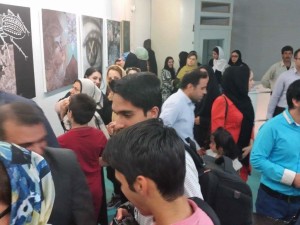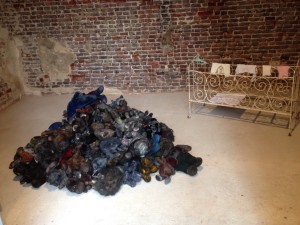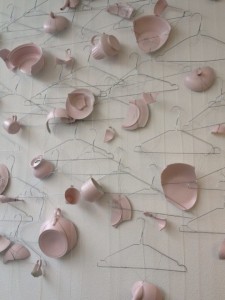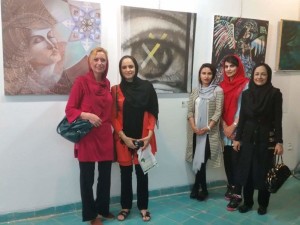Art connects and knows no boundaries
Visual artist Carmen Heemels is a collector of "things" that she makes her own by manipulating them. Later she connects the objects or memories. She asks questions and enters into a dialogue with the viewer. The answer is up to the viewer, or at least the work prompts a search. She also makes photographic portraits of women who have something to tell. She captures their story in the look of their eyes. Besides being a visual artist, Carmen Heemels is also a project manager/curator of (inter)national art events and a teacher of visual education. Carmen Heemels exhibits in the Netherlands and abroad.

Whether I wanted to come along. To Iran, Carmen asked. I didn't have to think about that for long, fanatical traveler as I am. My sister's work was on display at the People and Eastern Art exhibition in Ahwaz and later Dezful. Carmen had answered a call on facebook by Iranian Abdolreza Rabeti for domestic and foreign artists to create visual works based on Persian poems. "On facebook there is a large international art network that I am part of," she says. "You get in touch via-via with each other and with projects that can be very interesting."
"When I saw that call, I felt immediately drawn to participate. I like poetry very much, write a poem myself once in a while. It was important to understand the content of the verses, so they were translated into English. Each artist could choose one. My eye immediately fell on the poem Half Facing the Sky by Ali Abdollahi. Is about connection. And what could be better than to connect east and west, in this case Iran and the Netherlands." That manifested itself in an artwork of mix media; photography, lacquer, copies and tape. It involves a black and white projection of two almost identical eyes that half overlap. The irises of both eyes are covered by a cross of yellow and white tape. At the bottom, two hands half-visibly fall together. "So now I had a reason, a theme, but normally my work arises naturally. I don't actually think about it. So I don't make a plan. The process is set in motion automatically, without me being able to explain how or why. Sometimes it has no purpose or meaning. I buy the material which I think can produce something or which I find beautiful or which touches me, but then I still don't know where it leads. Yet eventually everything falls into place." Laughs: "At least until now."
It was not possible to send the work itself to Iran. All participating artists were asked to take a photo and send it digitally. Hundreds of artists worldwide responded to this call. The organization made a selection of their creations for the exhibitions in Iran. Carmen's work was among them. Just like that of some art friends she knows through ArtNations, an international artist association from Munich. "I felt honored, of course. What was my surprise; I received an invitation to come to Iran to be present at the opening of the exhibition in Ahwaz! Everything would be arranged; accommodation, food. I did not want to miss this opportunity and honour. The intention was to fly to Iran with about ten artists, mainly from the Netherlands, Germany and the United States. For various reasons, one after the other dropped out. I myself wanted to go to Iran with all my heart, to get to know my art friends and the country personally, and I did everything in my power to go there. And so I stayed in touch with the Iranians. Soon I was the representative of the foreign art group in their eyes."
 "Why did I necessarily want to be there? Because I felt I already had a connection with those people. You know, through images we can communicate. Art connects. It is, as it were, a language that everyone understands. Boundaries disappear. There are only possibilities, no limitations. You get to know each other through art. You understand the other immediately because it is visual language, just as the sounds of music can touch anyone. Art evokes emotions that are universal." The first thing that literally warmed us was the temperature when we stepped off the plane at Ahwaz airport. We arrived deep into the night and it was thick 35 degrees Celsius. We actually had no idea what to expect and how to behave. Modesty seemed to be the best option. Fortunately, everything went very well and in no time we were at the baggage carousel. When we arrived outside, a small man with a brown suitcase firmly in his left hand welcomed us with a broad smile. He turned out to be Abdolreza Rabeti, the organizer of the exhibition and a visual artist himself. "Just call me Reza," he said, nodding his head to the side, which as it turned out many men do out of modesty.
"Why did I necessarily want to be there? Because I felt I already had a connection with those people. You know, through images we can communicate. Art connects. It is, as it were, a language that everyone understands. Boundaries disappear. There are only possibilities, no limitations. You get to know each other through art. You understand the other immediately because it is visual language, just as the sounds of music can touch anyone. Art evokes emotions that are universal." The first thing that literally warmed us was the temperature when we stepped off the plane at Ahwaz airport. We arrived deep into the night and it was thick 35 degrees Celsius. We actually had no idea what to expect and how to behave. Modesty seemed to be the best option. Fortunately, everything went very well and in no time we were at the baggage carousel. When we arrived outside, a small man with a brown suitcase firmly in his left hand welcomed us with a broad smile. He turned out to be Abdolreza Rabeti, the organizer of the exhibition and a visual artist himself. "Just call me Reza," he said, nodding his head to the side, which as it turned out many men do out of modesty.
The warmth with which the people met us cannot be described in words. I've traveled extensively, but I've never experienced anything like it. Everyone insisted that we didn't have to do or pay anything. Everything was taken care of; the accommodation, the food, the transportation, the visits to the most special places in the province of Khoezistan, such as the oldest functioning bridge in the world in Dezful (7000 years old), a former bathhouse where dozens of people welcomed us and the 3000 year old step pyramid Chogha Zanbil in the city of Susa.
On the first day, after we had eaten our extensive - and of course free - breakfast, we were given a guided tour of the Contemporary Arts Museum in Ahwaz, where the exhibition was still in progress at the time. It was a building with enormous rooms and lots of light, also from above by means of large windows in the ceiling. For the first time we could take a look at the artworks of everyone who was selected. Most of the artists were from Iran, although there was also a lot of work by Dutchmen and Germans. The 'offer' was very international, with artists from Argentina, the United States and Australia, among others. One person immediately stood out with his art: Iranian Hamid Nourabadi and his land art. A video by him showed a person who had become one with the earth. Hamid had buried the model in a river-bed, covered him with mud, plants and stones, as if he were part of the landscape. The head had been partially released and the face was the same color as the wet sand. Yet the breathing was still visible. Carmen: "With that, he shows respect. He goes along with life, the cycle of the earth. In the cadence of nature. That's how he lives too, very calm and natural."
 And indeed, Hamid comes across as a man in balance, who has found peace and his mission in life. "Furthermore, I was very impressed by the paintings of Ali Amouri, also from Iran," she says. "He creates large portraits where the emotion splashes off. With intense colors. Or all green, or yellow, or blue. Monumental work. Penetrating and honest at the same time." Incidentally, Amouri looks a bit like Rolling Stones guitarist Keith Richards when he was young, but that's just by the by. In the evening, the manager of the museum invited us to explore the city with him, his wife, baby, nephew and supporters. Among other things, we visited an allegedly famous street with only falafel restaurants. In one of the restaurants, where the manager is a familiar face, we were allowed to eat our food in a cool room at the back of the building. Of course we did not have to pay anything. We were guests, so everything had to be free for us. By the way, in Iran it is often customary to eat in a cross-legged position on a Persian carpet. The seating area - made of wood or stone - is just slightly higher than the floor. Before entering it, you take off your shoes. At the falafel restaurant, it was no different. As if that wasn't enough, we went for a picnic by midnight. A strange sensation because of the late hour. But pleasant, because it is often the only time when the temperature is tolerable.
And indeed, Hamid comes across as a man in balance, who has found peace and his mission in life. "Furthermore, I was very impressed by the paintings of Ali Amouri, also from Iran," she says. "He creates large portraits where the emotion splashes off. With intense colors. Or all green, or yellow, or blue. Monumental work. Penetrating and honest at the same time." Incidentally, Amouri looks a bit like Rolling Stones guitarist Keith Richards when he was young, but that's just by the by. In the evening, the manager of the museum invited us to explore the city with him, his wife, baby, nephew and supporters. Among other things, we visited an allegedly famous street with only falafel restaurants. In one of the restaurants, where the manager is a familiar face, we were allowed to eat our food in a cool room at the back of the building. Of course we did not have to pay anything. We were guests, so everything had to be free for us. By the way, in Iran it is often customary to eat in a cross-legged position on a Persian carpet. The seating area - made of wood or stone - is just slightly higher than the floor. Before entering it, you take off your shoes. At the falafel restaurant, it was no different. As if that wasn't enough, we went for a picnic by midnight. A strange sensation because of the late hour. But pleasant, because it is often the only time when the temperature is tolerable.
The next day, the entire exhibit was moved to the Cinematic and Cultural Complex in Dezful, which houses a museum, a music studio and theater in addition to a museum. The manager of the museum in Ahwaz was kind enough to take Carmen and me halfway along the route of about 200 kilometers, where artist Hamid took over from him and dropped us off at our new home. A painting and drawing workshop was held in the cultural complex especially for our arrival, with dozens of artists participating. "It's actually not my specialty at all," Carmen laughed. She also participated, but she was not at all satisfied with her work. "It doesn't really matter. It's all about the atmosphere and the feeling of sharing a passion."
 A day later, the results were discussed. "They asked me what I thought about it. But that's not what it's about as far as I'm concerned. So I didn't give an opinion about it. What I think is more important is the intention with which something is made. I did ask the artists about that. Art is subjective. It's about the turmoil. The process. If it evokes an emotion or questions, it's successful for me." The opening of the exhibition at Dezful was quite a happening. Ceremonial even. A full program had been put together with speeches and performances by musicians and a drama group. For example, a three-man band played typical Persian music and an artist had written a song especially for our arrival. The drama group performed a play in an invented language that everyone understood. With both drama and humor, the struggle of life was portrayed at a high level. Carmen herself also gave a speech. She explained in English - with a translator beside her - that art is universal and can lead to a world where we are one, with the realization that we all have the same feelings and desires. She also thanked the Iranians for their extraordinary hospitality. To top it off, she was allowed to open the exhibition by cutting a ribbon amid great interest from the press and others. "It was extraordinary. Outrageous even. I really didn't expect this much honor and, to my mind, didn't deserve it. The cordiality of these people knows no bounds. Just like art."
A day later, the results were discussed. "They asked me what I thought about it. But that's not what it's about as far as I'm concerned. So I didn't give an opinion about it. What I think is more important is the intention with which something is made. I did ask the artists about that. Art is subjective. It's about the turmoil. The process. If it evokes an emotion or questions, it's successful for me." The opening of the exhibition at Dezful was quite a happening. Ceremonial even. A full program had been put together with speeches and performances by musicians and a drama group. For example, a three-man band played typical Persian music and an artist had written a song especially for our arrival. The drama group performed a play in an invented language that everyone understood. With both drama and humor, the struggle of life was portrayed at a high level. Carmen herself also gave a speech. She explained in English - with a translator beside her - that art is universal and can lead to a world where we are one, with the realization that we all have the same feelings and desires. She also thanked the Iranians for their extraordinary hospitality. To top it off, she was allowed to open the exhibition by cutting a ribbon amid great interest from the press and others. "It was extraordinary. Outrageous even. I really didn't expect this much honor and, to my mind, didn't deserve it. The cordiality of these people knows no bounds. Just like art."


